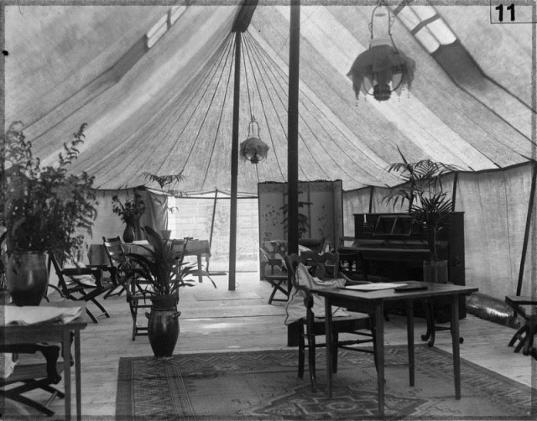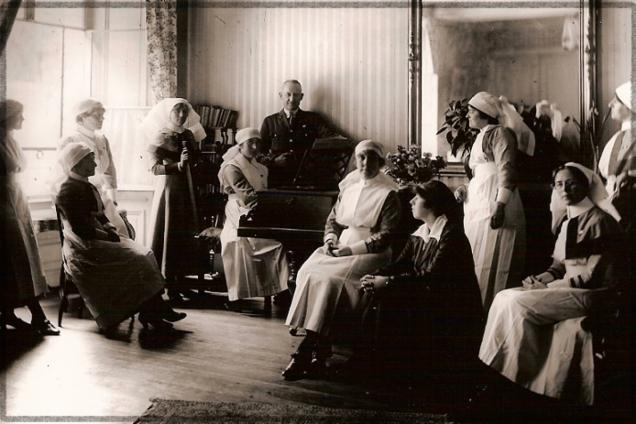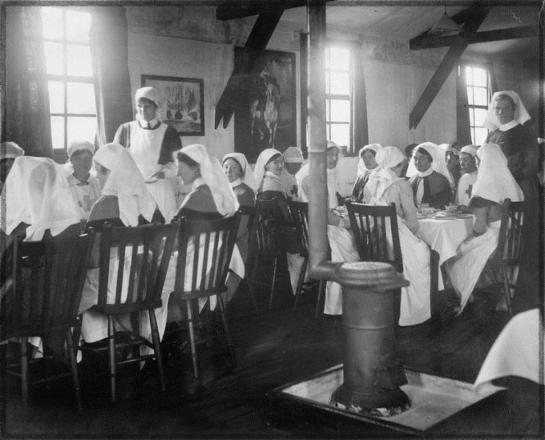THE FAIREST FORCE
11. LIFE IN THE SISTERS' MESS
*****
Wherever military nurses were stationed, a Sisters’ Mess was formed in any available accommodation, which could be rooms in an existing building, a hut or a marquee. As the holders of officer status, all nurses, whether trained or untrained, had servants to wake them, to bring hot water for washing, to clean their rooms and cook their meals. In most locations those servants were either British VADs or women drawn from the civil population in France and Belgium. Occasionally some heavier duties would be carried out, where appropriate, by male orderlies. Although working hours were long and the duties often onerous, the women were at least relieved of any domestic duties during their free time.
Sisters' Mess Tent, No.7 General Hospital, Malassises [IWM Q28902]
During wartime, the pay of all nursing staff in France included £54.12s, or one guinea a week, which was deducted from their pay for board and lodging. In addition they received Field Allowance at the rate of 3s. a day – another guinea each week. Field Allowance took into account the additional expense incurred while serving overseas. It also allowed nurses to buy extra food and comforts to augment army rations, and for this they each paid one franc per day into a Mess fund. [120] This could be spent on anything thought necessary to improve living conditions, from local fruit, vegetables and wine, to linen napkins, tablecloths and soft furnishings. Miss McCarthy often had to remind Matrons and Sisters-in-Charge of units that the money was there to be spent and not saved.
After lunch to Lahore British Hospital. Hospital good. Sisters’ quarters very bare and comfortless – staff apparently saving all they can, sooner than supply themselves with decent homelike surroundings. Told Miss Burkitt the Matron to alter matters, and to make like in all other Hospitals, each member to pay 1 franc a day into the Mess for extra comforts and dainties. [121]
Letter from Miss Barwell, A/Matron, Section A, 5 Stationary Hospital saying now that they were all only drawing their salary, they could not afford to pay the franc a day into the Mess. Reminded her that everyone was still drawing 3/- a day Field Allowance. [122]

Nurses' Home and Hostel, Abbeville [IWM Q8038]
Unlike their male counterparts, nurses received no financial grant to form a Mess, a point put forcibly by the Matron-in-Chief:
It may not have been clearly understood that Sisters’ Messes are not run on the same financial basis as are those of R.A.M.C. Officers and other Regimental Messes, and consequently it would not appear that G.R.O. 6133 applies to Sisters’ Messes. When an Officers’ Mess is formed, a Government grant is made, whereas when a Sisters’ Mess is started, no grant or assistance whatsoever is given, and all initial outlay has to be met by each individual member of the mess contributing privately a certain sum, or by the Matron meeting all expenses from her own private income, until the mess becomes self-supporting. In order to enable any mess to be run on a sound basis, a sufficient sum, that is one equivalent to at least one month’s outlay, must be kept in hand as a balance, and it is necessary for the Sisters to live very frugally until this sum is accrued. [123]
These financial disadvantages were often reflected in the standard of Mess accommodation provided for the nursing staff. Even as late as 1918 the Sisters’ Mess at No.53 CCS in Bailleul left a great deal to be desired:
The nursing staff are accommodated in small rooms at the ends of the big wards and their mess and ante-room was in a single-lined marquee in the grounds, badly lighted and with not even suitable or adequate heating conveniences, whereas the Medical Officers had a large hut, with kitchen, scullery, ante-room and mess, with fine big open brick grates in each room. Here we had lunch. I reported this matter to the General later as it is one of the exceptions in all the Armies where the Medical Officers have failed to consider the comfort and actual necessities of the nursing staff.[124]
Items available to them as ‘extras’ from the one franc per person per day levied, depended to an extent on where their unit was situated. Fresh vegetables, fish, eggs, milk and butter might be in abundance in one area but absent elsewhere. It also seems to be the case that in areas where large numbers of soldiers were stationed they were likely to be given preference when appealing to local providers for supplies:
I then went to 9 C.C.S. which was in full working order and had had a very busy week ... Everything seemed to be going smoothly. In this area … there are two great difficulties – the difficulty of getting their own and the Clearing Station washing done and the difficulty of buying extra supplies for the mess, fresh vegetables, milk and eggs being impossible to obtain, all there is to be had being sold to the soldiers resting near, at very high prices.[125]
During the first year of the war most of the cooks employed in Sisters’ Messes were army men, but later it was found convenient to employ VAD cooks in larger hospitals who could live and work alongside the nursing staff and also come under the authority of the Matron or Sister-in-Charge. In many smaller units such as casualty clearing stations the arrangements for both shopping and cooking were shared between the RAMC officers and the nursing staff which could prove both a disadvantage and a blessing. At No.29 Casualty Clearing Station the nurses felt that the money they were paying into the Mess fund was not well spent:
Their messing arrangements are not too satisfactory, in consequence of the officers and nursing sisters sharing one kitchen and the arrangement for shopping being that a young officer should do the shopping for both Medical Officers and sisters and the result is not as satisfactory as elsewhere.[126]
While at No.54 Casualty Clearing Station the wartime ‘chef’ proved most satisfactory:
All the cooking, both for the hospital, officers and sisters, is done in the hospital kitchen, the cook being a solicitor. I had lunch there and it was extremely good in every way. [127]
Food in France could perhaps be best described as plentiful but plain. The basic army ration given below was drawn up for members of the women’s army (QMAAC/WAAC) and nursing staff received rations on a very similar scale. Women received a slightly smaller army ration than men, their need assessed as being 94% of the full amount. In addition, as the war progressed, the proportions of protein, flour and sugar were adjusted for women to meet their slightly different dietary needs, resulting in the following daily quantities :
Meat 8 ounces
Bread 11 ounces
Bacon 2 ounces
Cheese 1 ounce
Milk 2 ounces
Margarine 1 ounce
Fresh Vegetables 4 ounces
Potatoes 8 ounces
Jam 3 ounces
Sugar 2 ounces
Rice or Oatmeal 2 ounces
Tea, Coffee or Cocoa 1 ounce
Salt ¼ ounce
Mustard 1/100th ounce
Pepper 1/100th ounce [128]
Even allowing for the extras paid for out of the Mess fund, it took a cook of some experience to produce a range of nourishing food within the budget supplied. Miss McCarthy spent much of her working time in France visiting and inspecting hospitals and casualty clearing stations. Although she saw her primary role as ensuring that the best possible nursing care was being delivered to the sick and wounded, she was especially careful to foster good relations with all members of her staff. During these visits she listened carefully to what they were saying and investigated any complaints that were raised. Although she could often be hypercritical and disapproving if her exacting standards were not met, she was also quick to praise energy and enterprise. During her long days on the road she took her meals at one of the hospitals on her list of visits, usually without notice. It was true that on any particular day she was unlikely to know where she would be at lunchtime, but it was also a useful opportunity for her to drop in unannounced and get an accurate snapshot of what everyday life was like. She felt that mealtimes and the welfare of her staff were important enough to deserve extensive entries in her war diary. On one unannounced visit in Etaples she noted:
Had lunch at 24 General in Sisters’ Mess; quite unexpected – everything most comfortable – well served – appointments good – cooking excellent – plenty of everything – roast beef, potatoes, cauliflower, apple tart, cheese, fruit and coffee for everyone.[129]
And also in Etaples, but at a different hospital:
Went with the Matron, Miss Hartigan, to lunch at 26 General Hospital where I had lunch in the sisters’ mess. It was an unexpected visit but everything was excellent: table, cloths, flowers, tables nicely laid and a very good lunch, including soup, cold meat (bully beef and ham) hot milk pudding and cheese. Everyone looked extremely well and everything appeared to be running smoothly. [130]
A Nurses' Dining Room in France, location unknown [IWM Q8110]
Nurses were not always in complete agreement with her about the standard of their hospital food. Elsie Tranter was a member of the Australian Army Nursing Service working at No.26 General Hospital. In her diary she confirms that the bully beef mentioned above was certainly in abundance in the dining-room, but she was not quite as satisfied with her lot as the Matron-in-Chief:
I don’t know that I’d exactly term our style of living here a luxury at home. In our mess, the food is mostly tinned and we ring the changes on bully beef – hot, cold and lukewarm … One night never to be forgotten we had potatoes for dinner. Poor little Daisy hardly eats enough of anything to keep a sparrow alive but she enjoyed her potatoes (about a spoonful each) and asked if she might have some more. Home Sister came down and before everyone at the table she said to Daisy ‘Don’t you know we’re on rations? If you have any more, someone else will have to go without.’ … Another morning we came over to breakfast after a hard night’s toil and found one sardine sitting on each plate, looking so lonely. I was hungry enough to eat an ocean full, but Peg said, ‘Never mind Trannie dear, you don’t look so silly beside that sardine as I do.’ C’est la guerre![131]
Where arrangements failed to meet her expectations, Miss McCarthy had the skill to negotiate a fine line between compliments, criticism and advice. She was insistent that the nursing staff should eat in surroundings similar to those they would expect in their own homes, and was always delighted to find well set tables. She also had a decided aversion to oilcloth or ‘American cloth’:
Went to 6 General Hospital just in time for lunch. Had lunch in the sisters’ mess. I really visited this unit with a view to seeing how the nursing staff were fed and accommodated, as certain complaints had been made. We had stew, potatoes and vegetable marrow, ground rice pudding and jam, cheese, butter, and wine and water to drink. There was no tea or coffee afterwards. There was American cloth on the tables. The meal was well cooked and well served and there seemed to be plenty of everything. The Home Sister served at a side table and there were V.A.D.’s and two batmen waiting. Everyone looked extremely well and there was quite a pleasant feeling in the mess, everyone chatting and appearing quite at home. After lunch I saw all the V.A.D.’s together as a complaint had been made with regard to the housing of the V.A.D.’s. I told them exactly what I had come about – all told me that they had no complaint of any kind to make – they were very happy and had plenty to eat – they could always have a second helping if they wished. I also impressed upon them that they were not to keep wine or spirits in their rooms as they always had wine at table. I told them that in all difficulties they should consult their Matron or send me a letter through her if they preferred. I saw the Matron afterwards and told her what I had said and asked her to make arrangements to have proper table-cloths and table-napkins provided and to have tea or coffee after both lunch and dinner, and impressed upon her that the habit of taking tea in the wards must be discontinued.[132]
Nurses in France and Flanders could expect to be transferred between medical units on a frequent basis, often experiencing life in more than a dozen different places during the course of their service. Although governed by the same rules and regulations, each would have a wide variety of features, making it a unique experience in living and working. Differences were not only the result of the building bricks provided – the tent, the hut, the dining-room of a hotel – but also of the personalities and skills of the women themselves who took the raw materials and out of it created a home, 'for the duration’ at least.
*****
[120] The official military exchange rate being five francs to 3s. 7d., so a weekly payment of about five shillings. For details of the temporary withdrawal of Field Allowance in 1916, see section six, ‘Pay.’
[121] War Diary of the Matron-in-Chief, The National Archives, WO95/3988, 15 December, 1915
[122] War Diary of the Matron-in-Chief, The National Archives, WO95/3989, 24 January, 1916
[123] War Diary of the Matron-in-Chief, The National Archives, WO95/3991, 13 March, 1919
[124] War Diary of the Matron-in-Chief, The National Archives, WO95/3990, 6 January, 1918
[125] War Diary of the Matron-in-Chief, The National Archives, WO95/3989, 30 September, 1916
[126] War Diary of the Matron-in-Chief, The National Archives, WO95/3990, 7 December 1917
[127] War Diary of the Matron-in-Chief, The National Archives, WO95/3990, 1 May, 1918
[128] Imperial War Museum, Women’s Work Collection, Army3/27/10
[129] War Diary of the Matron-in-Chief, The National Archives, WO95/3989, 8 October, 1916
[130] War Diary of the Matron-in-Chief, The National Archives, WO95/3990, 4 December, 1917
[131] In All Those Lines, the diary of Elsie Tranter, Gillings and Richards, 2008
[132] War diary of the Matron-in-Chief, The National Archives, WO95/3990, 14 September, 1917
